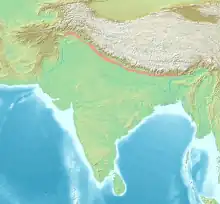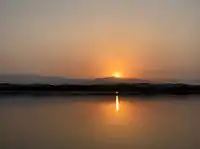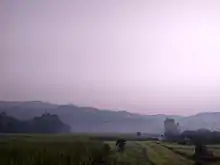Sivalik Hills
The Sivalik Hills, also known as the Shivalik Hills and Churia Hills, are a mountain range of the outer Himalayas that stretches over about 2,400 km (1,500 mi) from the Indus River eastwards close to the Brahmaputra River, spanning the northern parts of the Indian subcontinent. It is 10–50 km (6.2–31.1 mi) wide with an average elevation of 1,500–2,000 m (4,900–6,600 ft). Between the Teesta and Raidāk Rivers in Assam is a gap of about 90 km (56 mi).[1] The literal translation of "Sivalik" is 'tresses of Shiva'.[2] Sivalik region is home to the Soanian archaeological culture.[3] The hills are well known for their Neogene and Pleistocene aged vertebrate fossils.[4]

Geology

Geologically, the Sivalik Hills belong to the Tertiary deposits of the outer Himalayas.[5] They are chiefly composed of sandstone and conglomerate rock formations, which are the solidified detritus of the Himalayas[5] to their north; they are poorly consolidated. The sedimentary rocks comprising the hills are believed to be 16–5.2 million years old.[6]
They are bounded on the south by a fault system called the Main Frontal Thrust, with steeper slopes on that side. Below this, the coarse alluvial Bhabar zone makes the transition to the nearly level plains. Rainfall, especially during the summer monsoon, percolates into the Bhabar, then is forced to the surface by finer alluvial layers below it in a zone of springs and marshes along the northern edge of the Terai or plains.[7]
Prehistory



The Sivalik Hills are well known for fossils of vertebrates, spanning from the Early Miocene, until the Middle Pleistocene, around 18 million to 600,000 years ago.[8][9]
Remains of the Lower Paleolithic Soanian culture dating to around 500,000 to 125,000 BP were found in the Sivalik region.[10] Contemporary to the Acheulean, the Soanian culture is named after the Soan Valley in the Sivalik Hills of Pakistan. The Soanian archaeological culture is found across Sivalik region in present-day India, Nepal and Pakistan.[3]
Sivapithecus (a kind of ape, formerly known as Ramapithecus) is among many fossil finds in the Sivalik region.[11]
A number of fossil ratites were reported from the Sivalik Hills, including the extinct Asian ostrich, Dromaius sivalensis and Hypselornis. However, the latter two species were named only from toe bones that have since been identified as belonging to an ungulate mammal and a crocodilian, respectively.[12]
Demographics
The low human population density in the Sivalik Hills and along the steep southern slopes of the Lower Himalayan Range created a cultural, linguistic, and political buffer zone between populations in the plains to the south and the hills beyond the Mahabharat escarpment, enabling different evolutionary paths with respect to language and culture.
In culture
The Indian Navy's Shivalik-class frigate is named after these ranges.
See also
- Subranges of Sivalik (from north to south)
- Geological subdivisions of Himalayas (from north to south)
- Indus-Yarlung suture zone
- Karakoram fault system
- Nyenchen Tanglha Mountains
- Main Himalayan Thrust
- Lower/Lesser Himalaya
- Geographical subdivisions of Himalayas (from east to west)
References
- Kohli, M. S. (2002). "Shivalik Range". Mountains of India: Tourism, Adventure and Pilgrimage. Indus Publishing. pp. 24–25. ISBN 978-81-7387-135-1.
- Balokhra, J. M. (1999). The Wonderland of Himachal Pradesh (Revised and enlarged fourth ed.). New Delhi: H. G. Publications. ISBN 9788184659757.
- Chauhan, P. (2016). "A decade of paleoanthropology in the Indian Subcontinent. The Soanian industry reassessed". In Schug, G. R.; Walimbe, S. R. (eds.). A Companion to South Asia in the Past. Oxford, Chichester: John Wiley & Sons. p. 39. ISBN 978-1-119-05547-1.
- Kaur, Anubhav Preet (October 2022). "New fossil mammalian assemblages and first record of ostrich from the Pinjore (Pinjor) formation (2.58–0.63 Ma) of Siwalik Hills near Chandigarh, northern India". Quaternary Science Reviews. 293: 107694. doi:10.1016/j.quascirev.2022.107694.
- Chisholm, Hugh, ed. (1911). . Encyclopædia Britannica. Vol. 25 (11th ed.). Cambridge University Press. pp. 163–164.
- Gautam, P.; Fujiwara, Y. (2000). "Magnetic polarity stratigraphy of Siwalik Group sediments of Karnali River section in western Nepal". Geophysical Journal International. 142 (3): 812–824. Bibcode:2000GeoJI.142..812G. doi:10.1046/j.1365-246x.2000.00185.x.
- Mani, M.S. (2012). Ecology and Biogeography in India. Springer Science & Business Media. p. 690.
- Nanda, A.C. (November 2002). "Upper Siwalik mammalian faunas of India and associated events". Journal of Asian Earth Sciences. 21 (1): 47–58. doi:10.1016/S1367-9120(02)00013-5.
- Patnaik, Rajeev (31 January 2013), "Chapter 17. Indian Neogene Siwalik Mammalian Biostratigraphy An Overview", Fossil Mammals of Asia, New York Chichester, West Sussex: Columbia University Press, retrieved 22 August 2023
- Lycett, S. J. (2007). "Is the Soanian techno-complex a Mode 1 or Mode 3 phenomenon? A morphometric assessment". Journal of Archaeological Science. 34 (9): 1434–1440. doi:10.1016/j.jas.2006.11.001.
- Kelley, Jay (1 May 1988). "A new large species of Sivapithecus from the Siwaliks of Pakistan". Journal of Human Evolution. 17 (3): 305–324. doi:10.1016/0047-2484(88)90073-5. ISSN 0047-2484. Retrieved 9 May 2022.
- Lowe, P. R. (1929). "Some remarks on Hypselornis sivalensis Lydekker". Ibis. 71 (4): 571–576. doi:10.1111/j.1474-919X.1929.tb08775.x.